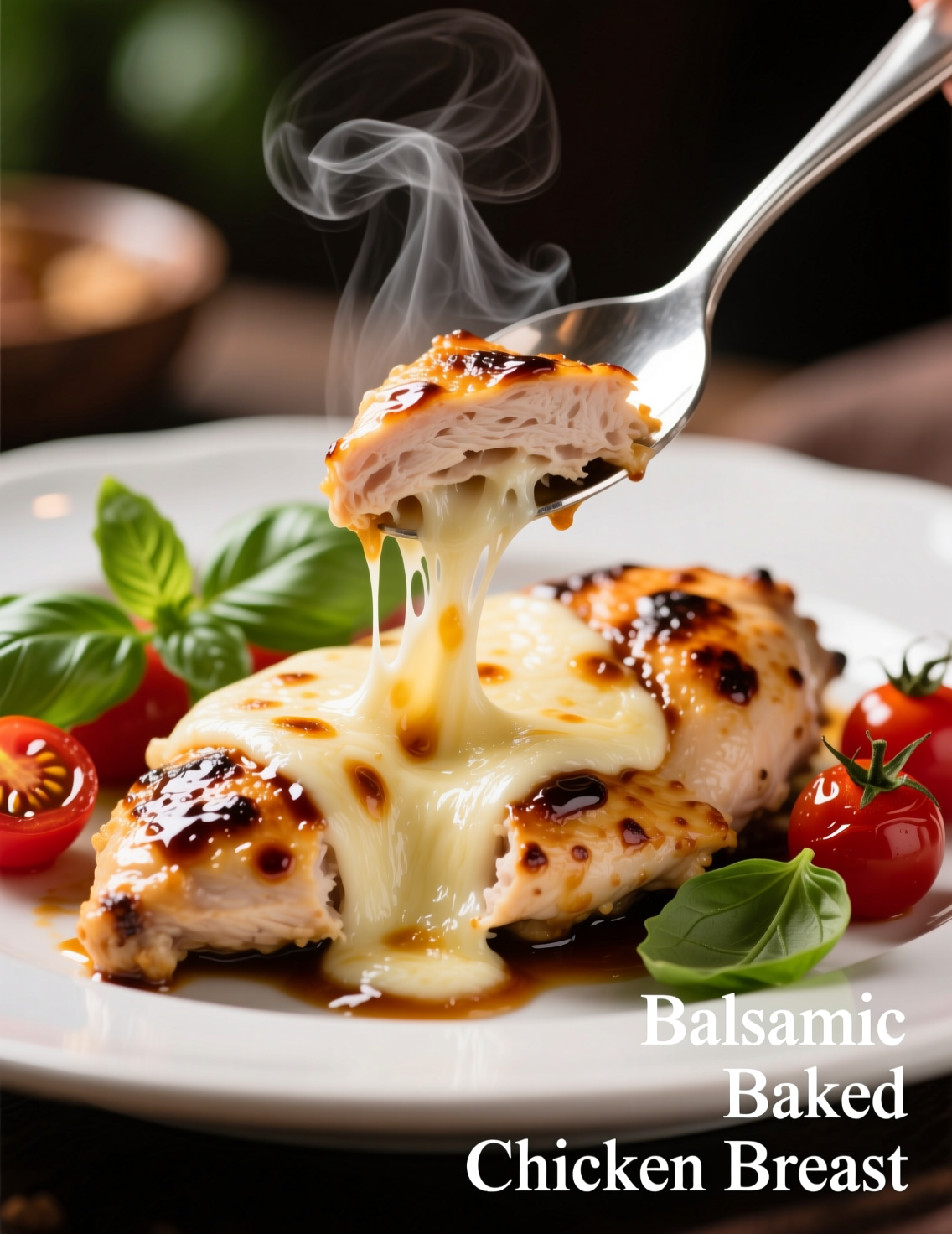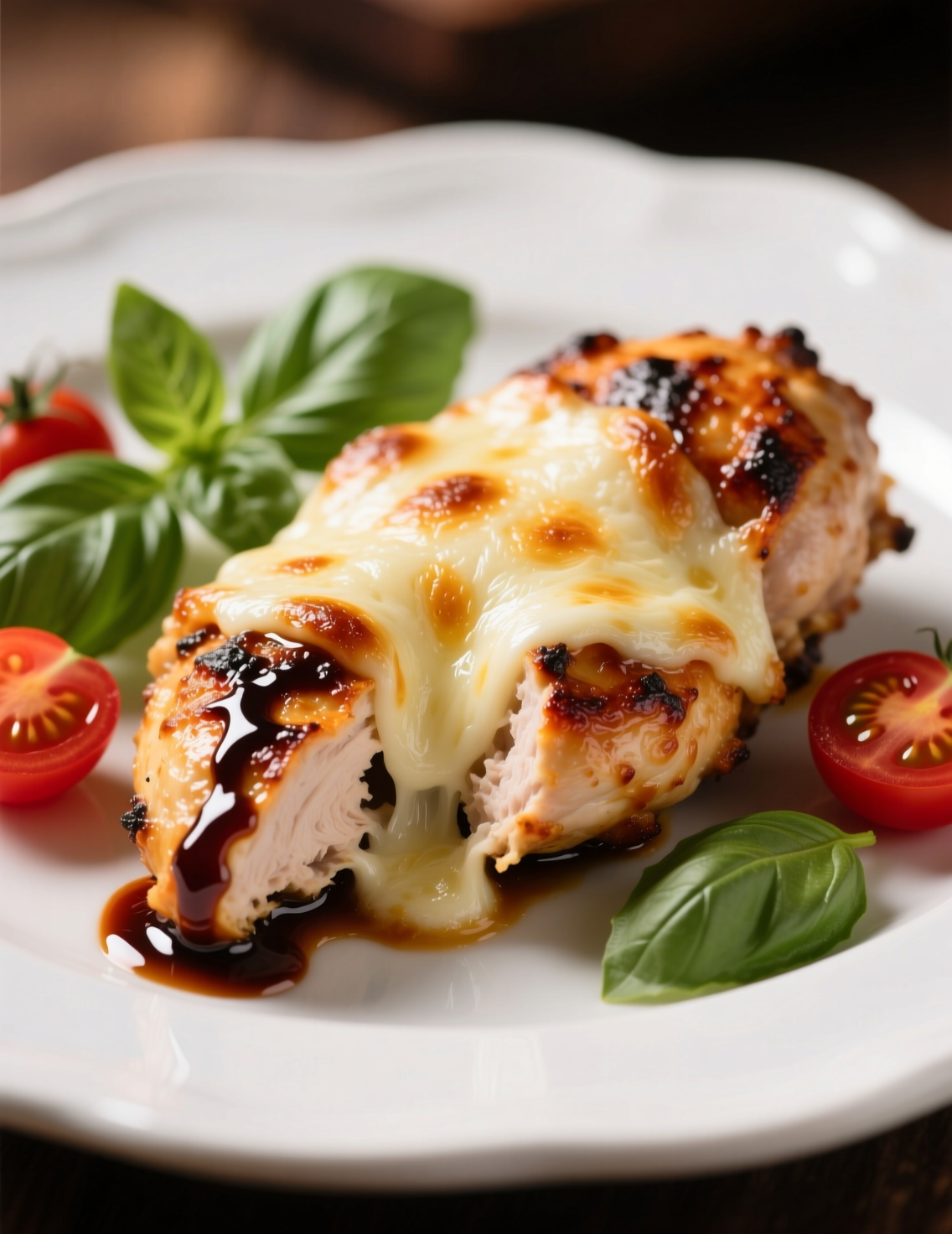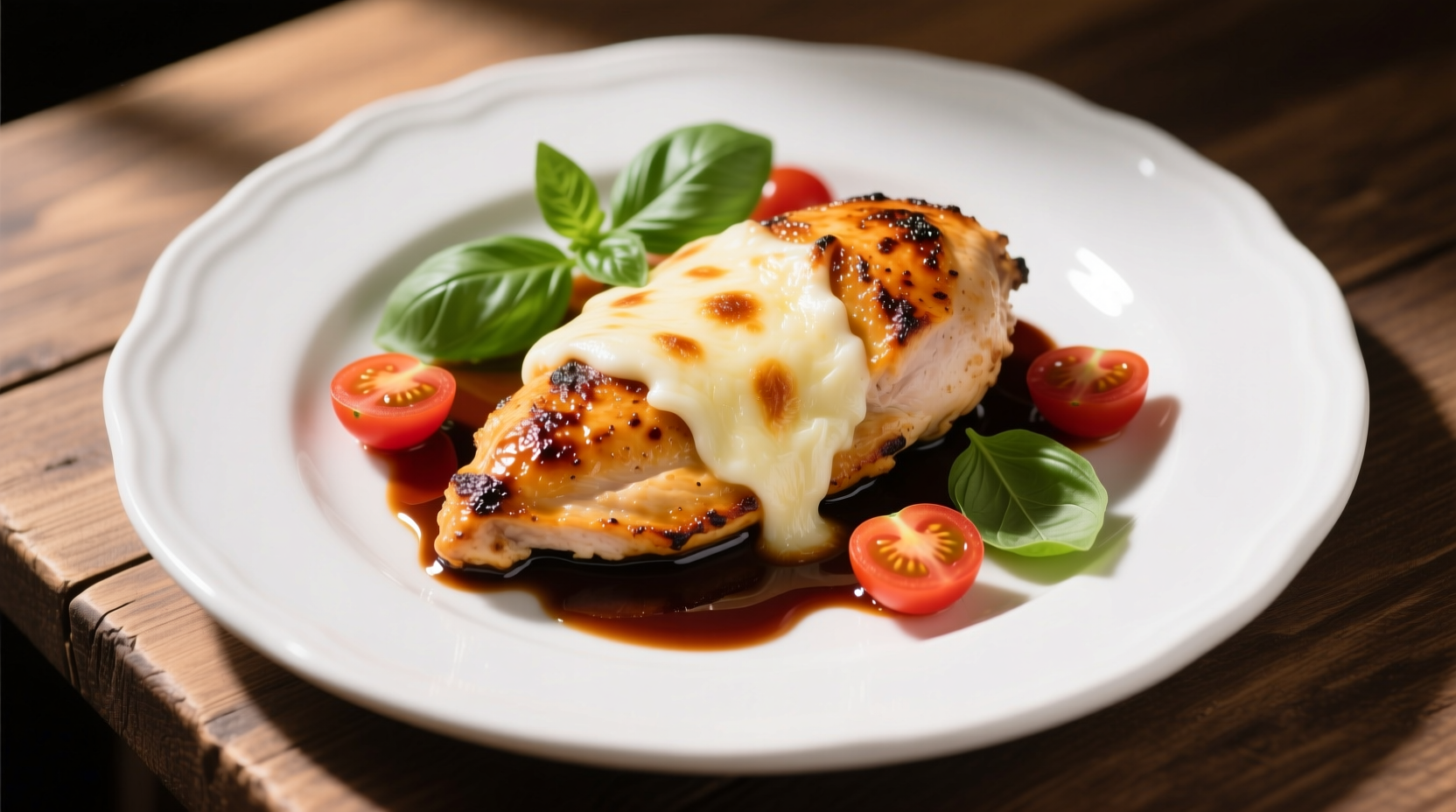Cooking chicken breast is a bit of a paradox. It’s simple in theory but tricky in practice. Too little time in the oven and you’ve got undercooked, rubbery meat. Too much and you end up chewing something that tastes like it belonged in a desert. Today we’re diving deep into a dish that balances flavor, science, and pure comfort—Balsamic Baked Chicken Breast with Mozzarella Cheese. It’s an elegant recipe for four servings, yet the depth behind it is enough to make even professionals pause and admire the chemistry happening on the plate.
Why Balsamic Works So Well
Balsamic vinegar isn’t just some trendy drizzle people toss on salads. It has a history dating back hundreds of years in Modena, Italy, where it was aged in wooden barrels until it became thick, tangy, and rich. Its acidity cuts through the natural heaviness of chicken breast. And let’s be honest, chicken breast doesn’t bring much personality on its own.
That sharp-sweet balance balsamic carries does two important things. First, it tenderizes the meat slightly because of the acid. Second, it creates a glossy reduction when baked, coating the chicken like a lacquer. This is why you don’t need ten different spices to make this recipe taste sophisticated. The vinegar and mozzarella together sing loud enough.
The Mozzarella Effect
Now, mozzarella. Fresh mozzarella has a high moisture content, and when heated, it does this gorgeous stretch and pull that people instinctively love. It melts at a lower temperature than aged cheeses, which makes it the perfect topper for baked chicken.
Here’s something often overlooked: mozzarella is mild. On its own, it won’t shout. But when paired with balsamic’s acidic punch, the fat and protein in the cheese mellow the vinegar’s sharpness. You get balance on the palate—something chefs chase constantly. The best dishes always sit right between contrast and harmony, never too far on one side.
Ingredients You’ll Need (For 4 Servings)
- 4 boneless, skinless chicken breasts (about 6 oz each)
- 1/3 cup aged balsamic vinegar
- 2 tablespoons extra-virgin olive oil
- 2 garlic cloves, finely minced
- 1 teaspoon dried oregano
- 1 teaspoon sea salt
- ½ teaspoon freshly cracked black pepper
- 1 ½ cups shredded mozzarella cheese (fresh if possible)
- 2 medium Roma tomatoes, thinly sliced
- Fresh basil leaves, torn by hand
That’s it. Notice the restraint here. Many recipes load chicken with spices until it feels like a pantry dump. This one doesn’t need that. It relies on high-quality ingredients and good technique.

Step-by-Step Method
Preparing the Chicken
Pat the chicken breasts dry first. Always dry protein before cooking—moisture on the surface leads to steaming instead of browning. Brush each breast with olive oil. This not only adds flavor but also helps the seasoning stick.
Season both sides with salt, pepper, and oregano. Keep it simple. Salt penetrates muscle fibers when given a bit of time, so if possible, let the chicken sit seasoned for 15 minutes before it hits the oven.
The Balsamic Marinade
Mix balsamic vinegar, garlic, and a touch more olive oil in a small bowl. Pour this over the chicken in a baking dish. Don’t drown the meat. You’re not making soup here. Just enough liquid so each piece is coated and sitting in a shallow pool.
Let it rest for 20–30 minutes at room temp. This isn’t a long marinade—chicken breast doesn’t handle heavy acids well over hours. Too long and it becomes mushy. Quick marinating is perfect here.
Baking Process
Preheat your oven to 400°F (200°C). Place the dish uncovered in the middle rack. Bake for about 20–22 minutes, depending on thickness. Internal temp should read 165°F (74°C). No guessing. Use a thermometer—it’s not a toy, it’s an insurance policy.
Halfway through, spoon some of the balsamic liquid back over the chicken. This creates layers of flavor as it bakes. When you’re about five minutes from done, pull the dish out, top each chicken breast with mozzarella and a slice or two of tomato. Return it to the oven until the cheese melts and bubbles.
Once finished, scatter torn basil leaves on top. The heat will slightly wilt them, releasing essential oils.
The Science Behind the Flavor
Chefs often talk about “flavor building,” but what does that really mean here? The vinegar undergoes reduction during baking. Water evaporates, sugars concentrate, and the result is a sticky glaze clinging to the chicken surface. This reduction coats the palate differently than raw vinegar ever could.
Meanwhile, mozzarella’s milk proteins interact with the balsamic glaze, softening the acid’s sharp edges. The fat acts almost like a mediator, making the bite rounder. And tomatoes bring in a subtle umami sweetness that connects the dots. Basil? It’s your aromatic high note, cutting through the richness. Every component has a job.
Common Mistakes and How to Avoid Them
One big mistake—overbaking. Chicken breast has almost no fat. That means once it goes past 165°F, it dries out fast. Pull it at temp and let it rest a few minutes. Residual heat continues cooking, and juices redistribute.
Another mistake—using cheap balsamic. Those watery grocery store versions labeled “balsamic vinegar” often lack the body and sweetness you need. If you can, go for a bottle marked “Aceto Balsamico di Modena IGP.” It’s not the ultra-aged expensive stuff but still authentic enough to make a difference.
And finally—don’t use pre-shredded mozzarella if you can avoid it. Those are dusted with anti-caking starch that prevents smooth melting. Buy fresh balls or logs of mozzarella and shred them yourself.

Nutritional Insights
For four servings, each portion roughly contains:
- 310 calories
- 32g protein
- 12g fat
- 9g carbohydrates
It’s lean but satisfying. The protein makes it ideal for athletes or anyone tracking macros. The balsamic gives flavor without loading on sugar, unlike many glazes or sauces. And mozzarella adds calcium plus just enough indulgence.
Professional Applications
Restaurants can adapt this dish easily. It works well as a plated entrée with a side of roasted vegetables or polenta. It can also slide onto a catering menu—easy to prepare in batches, holds flavor even after resting.
For personal chefs, it’s a client-friendly option. Gluten-free by design, minimal carbs, and adaptable for different dietary restrictions. Want lower fat? Use part-skim mozzarella. Want richer flavor? Add prosciutto beneath the cheese for a layered twist.
Questions Chefs Often Ask
Can I use chicken thighs instead of breasts? Yes, but cooking times change. Thighs handle longer heat better and will end up juicier.
Can I prep ahead? Yes. You can season and marinate the chicken a few hours before, then bake just before serving. Don’t top with mozzarella until the final bake step.
Does this freeze well? Not really. Mozzarella loses its texture after freezing. The chicken itself can freeze, but the dish is best fresh.
A Trend Worth Noting
In recent years, dishes combining aged vinegar and cheese have surged on menus. According to the National Restaurant Association, over 68% of fine dining establishments now incorporate balsamic reductions in entrees. Customers crave bold yet recognizable flavors. This recipe fits that trend perfectly—familiar chicken, elevated with Italian notes.
Final Thoughts
Balsamic Baked Chicken Breast with Mozzarella Cheese isn’t complicated, but it shows how good cooking comes from restraint and respect for ingredients. You don’t need 20 spices or fancy techniques. Just balance, timing, and care.
For professionals, the lesson here is clear: never underestimate the classics. When you layer acid, fat, and umami thoughtfully, even the plainest cut of chicken becomes remarkable. Cook it right, serve it warm, and watch it disappear fast.
FAQs
What type of chicken is best for this recipe?
Boneless, skinless chicken breasts work best for even cooking.
Can I use chicken thighs instead of breasts?
Yes, but adjust baking time as thighs take longer to cook.
Do I need to marinate the chicken?
A short 20–30 minute marinade with balsamic and garlic enhances flavor.
What kind of balsamic vinegar should I use?
Use aged balsamic vinegar, preferably Aceto Balsamico di Modena IGP.
Can I use pre-shredded mozzarella?
Fresh mozzarella shredded by hand melts better and tastes richer.
What temperature should I bake the chicken?
Bake at 400°F (200°C) until internal temp reaches 165°F (74°C).
Can I prep this recipe ahead of time?
Yes, marinate the chicken a few hours before baking, but add cheese at the end.
Can this dish be frozen?
The chicken can be frozen, but mozzarella melts poorly after freezing.
Is this recipe gluten-free?
Yes, naturally gluten-free with no added gluten ingredients.
How many servings does this recipe make?
It serves four people generously.

Mariana is a passionate home cook who creates delicious, easy-to-follow recipes for busy people. From energizing breakfasts to satisfying dinners and indulgent desserts, her dishes are designed to fuel both your body and hustle.
When she’s not in the kitchen, she’s exploring new flavors and dreaming up her next recipe to share with the Foodie Hustle community.

